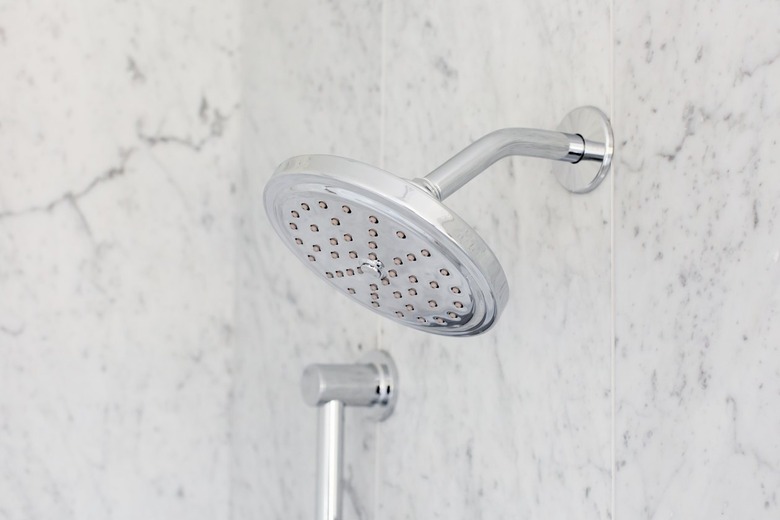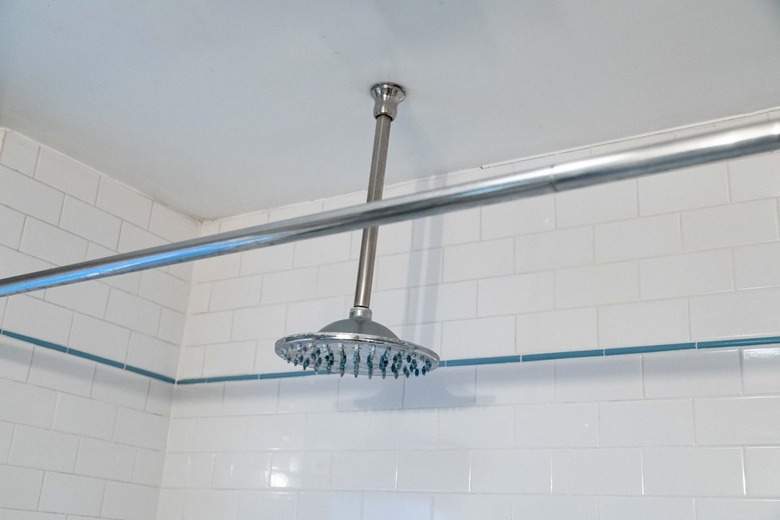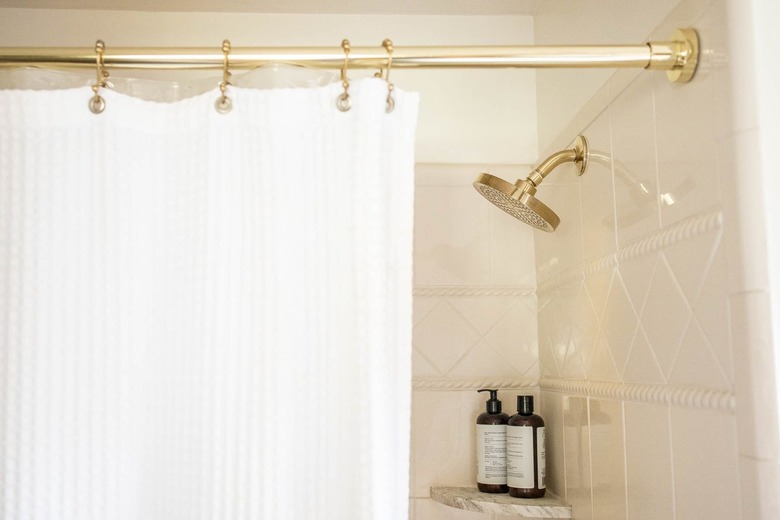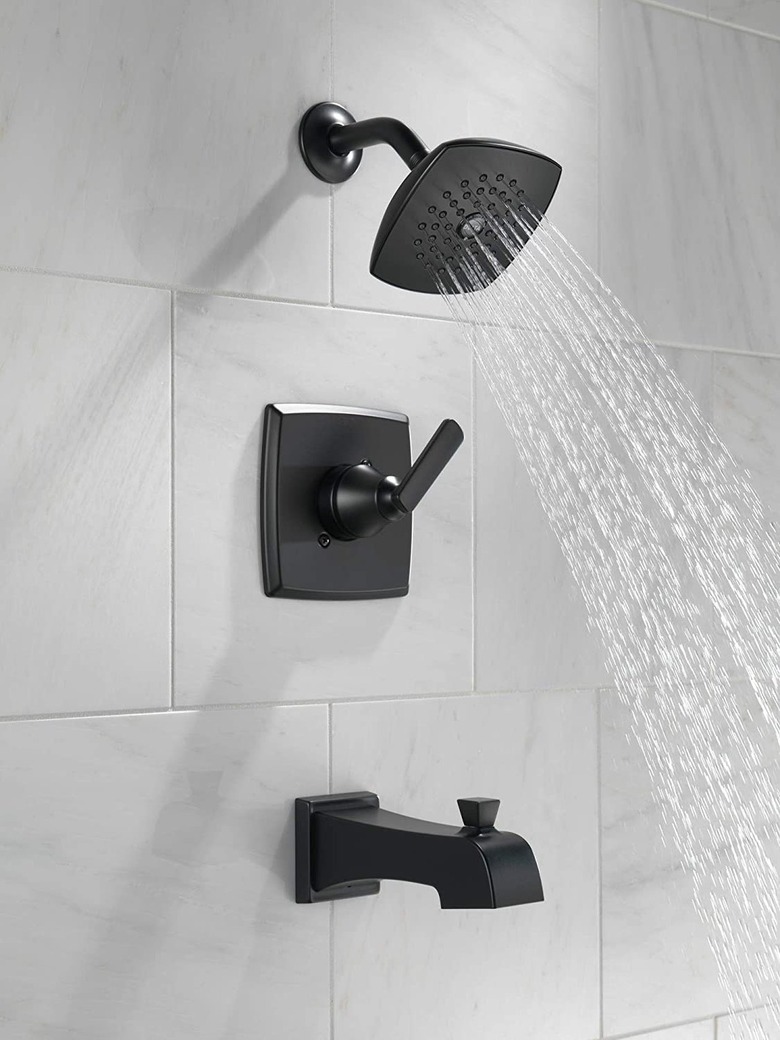How To Choose A Showerhead And Shower Faucet For A Spalike Bathroom
We may receive a commission on purchases made from links.
Choosing the right showerheads and shower faucets can be difficult for homeowners, particularly because everyone has such drastically different opinions on what makes a great shower. While one person may genuinely love the high pressure they get from a stripped-down chrome showerhead with no frills, their partner may long for a bronze luxury shower system with a rainfall showerhead, handheld sprayer, LED light, and Bluetooth stereo, all surrounded by a dozen body sprayers — and their best friend may want nothing more than a clawfoot bathtub with a freestanding tub/shower faucet featuring porcelain handles on the taps and the hand shower.
By learning about the many types of showerheads and shower faucets and their differing features, you'll have an easier time determining the right options for your bathroom given your personal tastes.
Different Showerhead Options
Different Showerhead Options
Long ago, there was only one type of showerhead available — a fixed showerhead protruding from the wall. These days, there are multiple types of showerheads, each with its own benefits. Even the humble fixed showerhead can be adjusted to different positions and fitted with multiple spray settings. Overall, fixed showerheads are the simplest to use and the least expensive option (the most basic models start at $5), but many people prefer to be able to direct the water with a handheld sprayer.
Handheld Showerheads
Handheld showerheads are connected to the shower's plumbing with a flexible hose that allows users to direct the spray where they want it. The sprayer can also be left in place and used like a fixed showerhead. For this reason, they are largely considered a step up from fixed showerheads, though they can still be found for a reasonably inexpensive price (decent models can be found for $15), and since they attach to a standard shower arm, most models can easily be installed by homeowners. Some handheld showerheads are secured to a slide bar, enabling users to adjust the showerhead based on their height. Handheld showerheads are a great option for anyone with limited mobility or for those who regularly need to wash their kids or pets. The sprayers also make it easier to clean your shower.
Dual Showerheads
For those who like directing the water with a handheld showerhead while still enjoying a fixed spray above the head, a dual showerhead is the perfect option. This brilliant combo offers almost all the pros of both fixed showerheads and handheld sprayers with none of the cons. There are even models available that feature a rainfall showerhead instead of a traditional fixed showerhead. One of the only downsides of these showerheads is that they can be a bit pricier than just a handheld sprayer or a fixed showerhead, with prices starting at $25, though this is still a reasonably affordable option that can provide you with an even more enjoyable shower experience.
Rainfall Showerheads
Rainfall showerheads allow users to enjoy the gentle, drip-drop feeling of bathing in the rain. They are commonly mounted from the ceiling, but this requires a plumber to set up a special connection, which is why many people prefer the models that can be fitted to a standard shower arm. While rainfall showerheads can become pricey, at the low end of the price spectrum, they are only slightly more expensive than more traditional options, starting at only $35. Affinity for rainfall showerheads varies from person to person. Those who like the relaxing, gentle feeling of rain falling on their head will enjoy these products, while those who like high-pressure showers will not. For the lowest-pressure options, look for the largest-possible showerhead since this will divide the water as much as possible, reducing the pressure from each individual spray nozzle.
Body Spray Showerheads
While most showerheads can be used alone, body spray showerheads are designed to be used as only part of a shower system since they only spray the body from the shower walls, meaning they do not wash the user's head. Because they are built into the wall, they require professional installation by a plumber. For best results, multiple body sprays should be installed so water sprays from all sides for a 360-degree shower experience.
Shower Systems and Panels
Shower Systems and Panels
When most people start talking about "dream showers," they're talking about a full shower system — a fully immersive experience that incorporates a combination of the rainfall showerhead, handheld showerhead, body sprayers, and fixed showerhead. The showerheads are only the beginning — they also typically allow users to choose the perfect water pressure and temperature and may also offer special lighting options and an integrated Bluetooth stereo. Shower systems are designed to be spalike experiences, and this level of luxury typically costs thousands of dollars, particularly since they require the installation of specialized plumbing connections in the ceiling and walls.
A slightly less expensive option that can be nearly as indulgent as a shower system is a shower panel. These multifunction systems still require a plumber to install them, but because they only sit on the same wall of your shower as a traditional showerhead, the installation is much cheaper. The panels are also far cheaper than a fully integrated system, with prices ranging between $150 and $1,000 depending on the range of features. While they may not have the full range of luxuries seen in shower systems, they are still very indulgent and typically have a wall-mounted rainfall showerhead, handheld showerhead, LED lights, and pressure controls, and they may also incorporate Bluetooth music players, body sprayers, massage sprayers, and scald-control features.
Before installing a shower system or shower panel, check with the local building authority to see if your area has any restrictions on the number of showerheads you can use, as this is common in areas where droughts are frequent. Also be prepared for a more expensive water bill and know that you may need a larger water heater to accommodate the increase in hot water usage in your home. If you're looking into a custom shower system, talk to a plumber to make sure your plumbing can accommodate the specific system you're considering since some require larger than average pipes.
Types of Shower Faucets
Types of Shower Faucets
Depending on your configuration, the bathroom faucets in the shower area may be equipped with a shower-only faucet or a bath-and-shower combo. The main difference between these two is that tub/shower faucets have a diverter device that lets you direct whether the water should come out of the tub spout or the showerhead.
While shower-only shower faucets may be configured with one or two handles, a shower and bathtub faucet combo may feature up to three handles. Designs with single handles use a single-function shower valve equipped with a knob or lever handle that can be adjusted somewhere between the hot and cold sides to select the ideal temperature and can be pulled out to increase water pressure. Most two-handle shower fixtures have one handle for the cold water and another for the hot water, while three-handle shower faucet sets have a knob to control the diverter. If a tub/shower configuration doesn't have three handles, the diverter will instead be a switch or a knob on or near the handle or the tub spout.
While wall-mount designs are the best selling option for both varieties, it is far more common to find deck-mounted shower faucets (those fitted into the edge of the tub) and freestanding faucets (those that stand on the floor outside the tub) in bath/shower configurations than shower-only setups. The great majority of deck-mounted and freestanding bathtub/shower faucets are only available with a hand sprayer showerhead since these are the easiest to control and direct into the tub, which can limit the water sprayed outside the tub.
Different Spray Settings
Different Spray Settings
Some showerheads, particularly inexpensive ones, have a single spray setting, but others let you switch up the spray pattern and pressure based on your personal preference. This is particularly useful if you and your partner don't agree on whether a shower should be invigorating or relaxing. Settings vary from one showerhead to another, but the most common patterns include:
- Wide or full spray: Sprays water from each
nozzle at a constant speed. - Targeted spray: Emits more pressure by
forcing water through fewer nozzles. - Rinse (what Delta calls "drenching" and Moen calls "downpour") spray: Water flows at a fast speed from large central
nozzles, leaving you feeling soaked quickly. - Pulsating or massage spray: Shoots water
out of nozzles in alternating patterns, creating a pulsing, massagelike
sensation. - Aerated (what American Standard calls "power mist") spray: Breaks up water streams so they mix with air, creating a
misty spray. - Pause mode: May not fully stop the water
flow but slows it dramatically in order to conserve water when you do not need
it to be actively flowing.
Many showerheads have in-between settings that utilize two of these settings at once — for example, full spray combined with a massage or targeted spray setting.
Consider Water Usage
Consider Water Usage
Modern showerheads are legally required to have a maximum water flow rate of 2.5 GPM, meaning they use no more than 2.5 gallons per minute at a standard water pressure of 80 PSI (pounds per square inch). Even so, showers are still the third-highest water-using appliance in most homes. If you're looking to help the environment or lower your water bill, look for low-flow showerheads with an Environmental Protection Agency WaterSense label, indicating that it uses less than 2 GPM.
While showerheads work optimally at standard water pressures between 45 and 80 PSI, they might not work as well as they are designed to work at much lower water pressures, such as 30 PSI or less. If you find that you have a hard time getting fully rinsed, look for a model designed for homes with low water pressure.
Showerhead and Shower Trim Materials
Showerhead and Shower Trim Materials
The decorative part of a shower faucet, including the showerhead, tub faucet, diverter, trim plates, and knobs/lever, are known as the trim. You can purchase a shower trim kit with all the pieces included, or you can buy the pieces individually. Whether you are buying a whole kit or an individual piece, they are all typically made from the same materials.
The interior of these products is typically made from stainless steel, brass, or plastic. In fact, most showerheads actually contain at least some plastic since the nozzles and interior lining are typically made from plastic. Similarly, many shower handle kits use plastic thread nuts since they do not rust or corrode when wet, which could cause the handles to fuse to the valves.
While some of the most high-quality showerheads have brass interiors, plastic is not necessarily an indication that a product is inferior. Plastic showerheads are lighter and are unsusceptible to rust and corrosion. They offer more spray options, and they are less expensive while still being reasonably durable. That being said, plastic is prone to harboring bacteria more than metal. It tends to get more mineral and lime deposits, and it is more prone to leaking or cracking.
Showerhead hoses may be made from plastic or metal and are frequently made with plastic wrapped in a light metal. Overall, it's best to choose a hose made entirely from stainless, as it hangs better than plastic, making these showerheads easier to use, and the material lasts longer without leaking.
The finish on showerheads and shower trim will have a dramatic effect on your bathroom's appearance. The most common finish is polished chrome, but there are many other finishes available, including brushed nickel, matte black, oil-rubbed bronze, copper, polished brass, and matte white.



